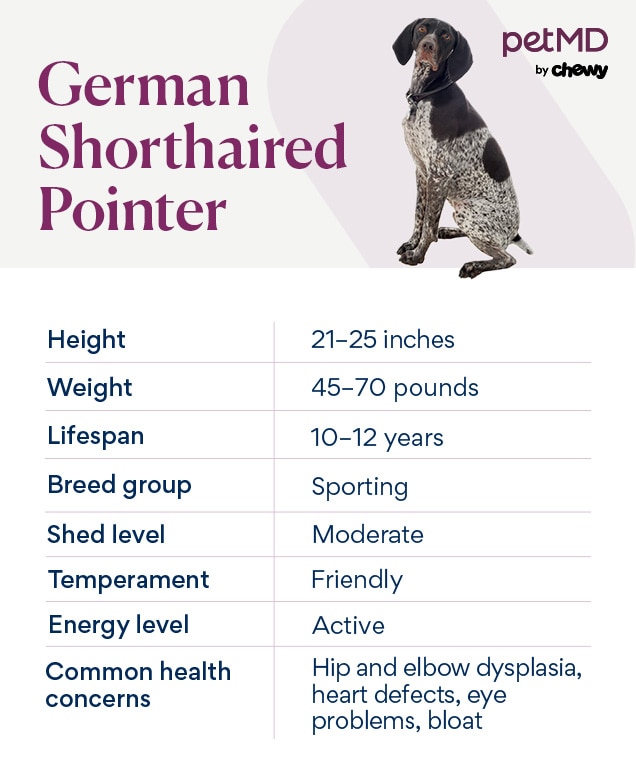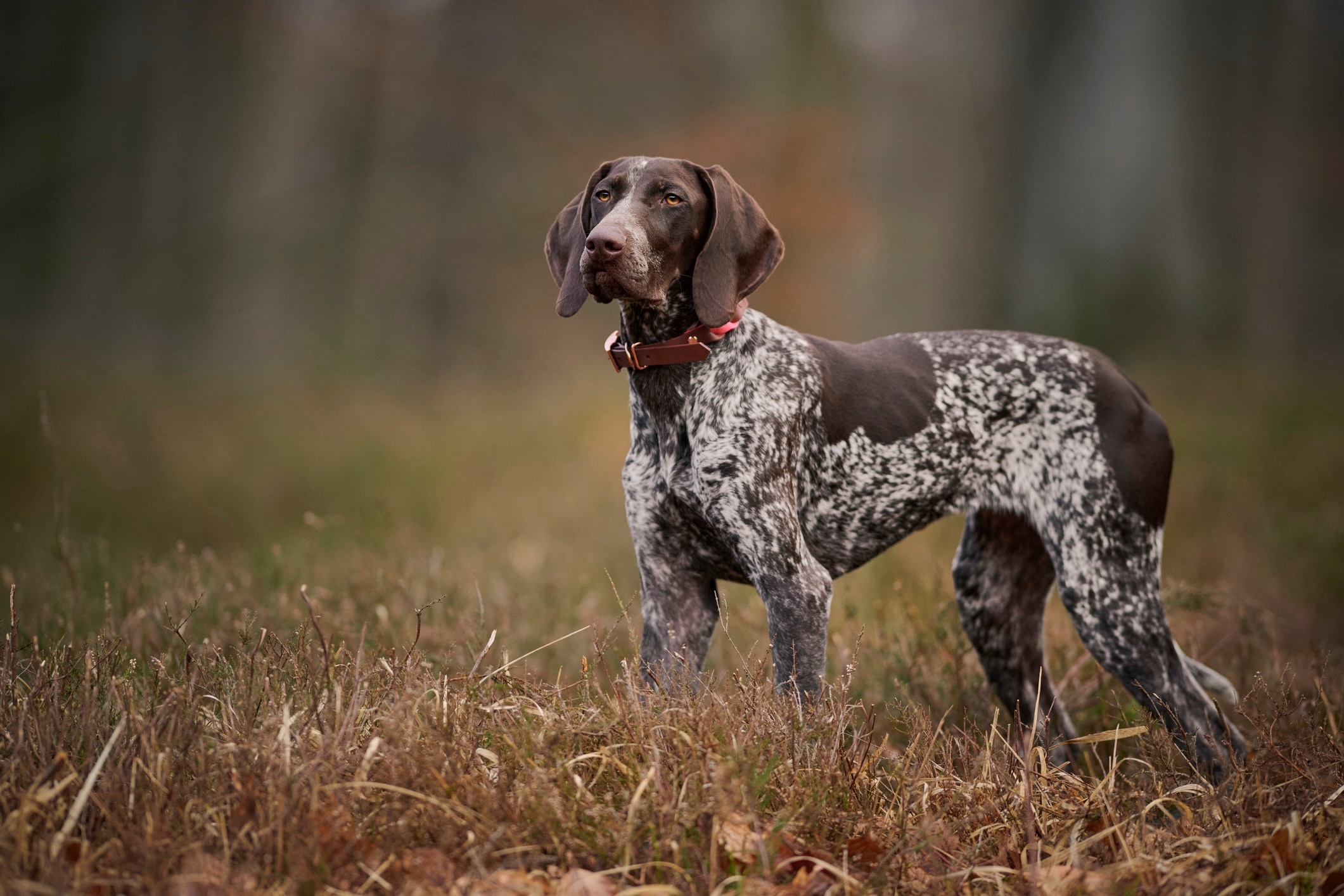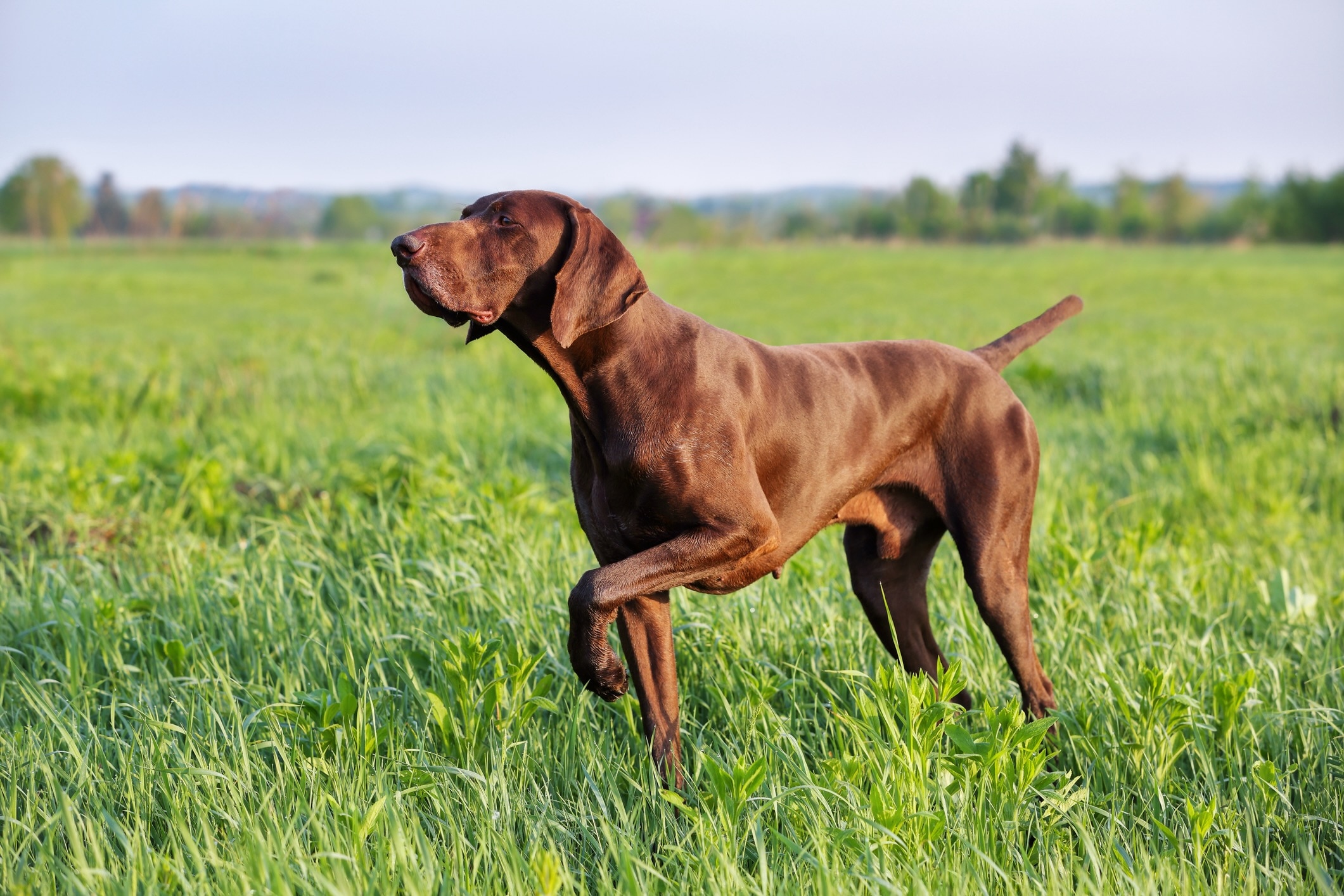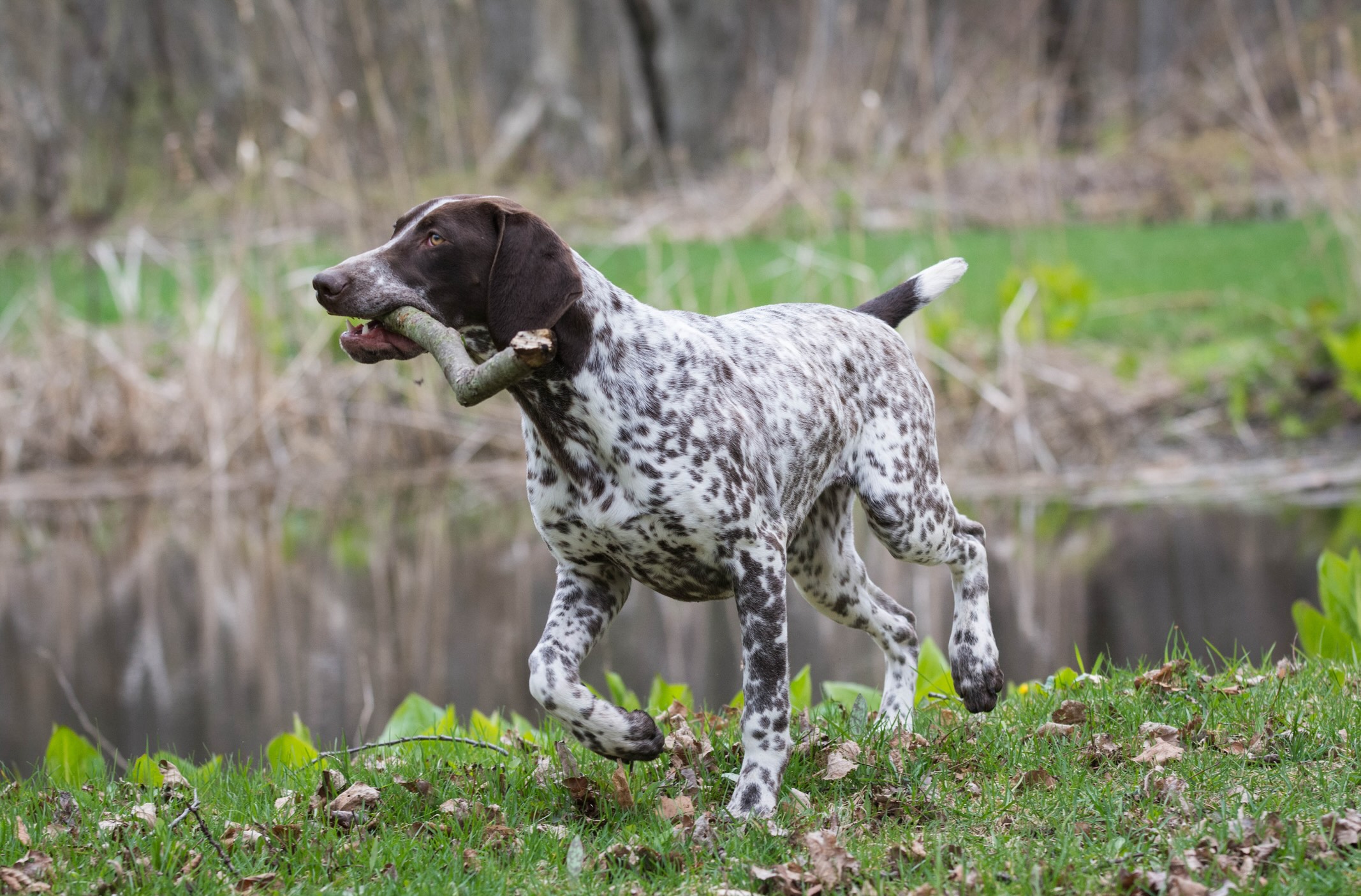German Shorthaired Pointer
Evgenia Glinskaia/iStock / Getty Images Plus via Getty Images
German Shorthaired Pointers are often described as noble or aristocratic in their appearance and are known for speed, agility, and endurance.
GSPs are known as “bird dogs”—aka, hunting dogs trained to find or retrieve game birds. GSP dogs, unlike other bird dogs, point and signal by stopping and standing with their nose pointed in the direction of the scent. In this stance, they await a signal from their hunter to flush out the animal.
As a medium-sized breed, the typical German Shorthaired Pointer size is 21–25 inches tall and 45–70 pounds. They are easily identified by their patched and ticked coat that’s often black or liver (brown) and white, though German Shorthaired Pointer colors also include solid liver.
Along with being well-loved hunting companions, German Shorthaired Pointers can make great family dogs who are always ready for any outdoor activity.
Caring for a German Shorthaired Pointer

German Shorthaired Pointers make excellent working dogs and hunting partners because of their high energy levels and endurance. For this reason, GSP dogs require homes with ample activity to keep them both physically and mentally stimulated.
Other than their need for adventure and exercise, German Shorthaired Pointers are fairly low-maintenance dogs with short coats that require minimal grooming and shed moderately. With families, they are loyal and loving and can do well with other pets and with children.
German Shorthaired Pointer Health Issues

The average German Shorthaired Pointer lifespan is 10–12 years. They are generally healthy dogs, but they can be prone to certain inherited conditions.
Hip and Elbow Dysplasia
Hip dysplasia and elbow dysplasia are conditions where the hip or elbow joints don’t align properly. This misalignment causes rubbing and grinding of the bones. Over time, this leads to deterioration and arthritis of the joint, causing pain and loss of function.
Hip and elbow dysplasia can be hereditary conditions that affect GSP dogs. However, they can also be exacerbated by factors such as exercise habits, weight, and nutrition. The conditions can be managed medically, but surgery may be needed in severe cases.
Progressive Retinal Atrophy
Progressive retinal atrophy (PRA) is a group of degenerative diseases that affect the eye’s retina, eventually causing blindness. PRA is an inherited disease that affects German Shorthaired Pointers, and symptoms include increased clumsiness (especially in the dark), reluctance to go outside at night, and cloudy eyes.
While this disease cannot be prevented or treated, there is a DNA test that can screen for the defective gene in potential carriers. Reputable German Shorthaired Pointer breeders will screen their dogs for PRA.
Subaortic Stenosis
Subaortic stenosis is an inherited disease seen in GSP dogs. It causes a narrowing of the aortic valve, which is responsible for regulating blood flow from the heart to the rest of the body. When the valve narrows, it causes the heart to work harder. If left untreated, it will eventually lead to heart failure.
Some common signs of subaortic stenosis include lethargy, decreased exercise tolerance, and fainting. The condition is typically detected by a veterinarian during an examination as a heart murmur in young dogs, often before they are 1 year old.
Treatment depends on the severity; mild cases may not require treatment, while more severe cases may warrant lifelong medications.
Gastric Dilatation-Volvulus
Gastric dilatation-volvulus (GDV), a severe case of bloat in dogs, is a condition that can affect deep-chested breeds such as German Shorthaired Pointers.
GDV is when a dog’s stomach swells and twists, cutting off blood flow to and from the stomach and spleen. This is a medical emergency and a dog experiencing GDV needs immediate veterinary care.
It’s important to know if your German Shorthaired Pointer is showing signs of GDV, which include:
-
Retching without producing vomit
-
Distended abdomen
-
Signs of abdominal pain, such as pacing and an inability to settle
-
Excessive drooling and panting
To help prevent GDV, prophylactic stomach tacking (gastropexy) surgery can be performed on German Shorthaired Pointers. This procedure secures the stomach to the abdomen wall to prevent future twisting.
What To Feed a German Shorthaired Pointer

Selecting the best diet for a German Shorthaired Pointer is based on the individual needs of the dog.
While it’s always important to choose dog food that meets the nutritional standards established by the Association of American Feed Control Officials (AAFCO), ask your veterinarian what to feed your GSP based on their specific medical history.
Due to their active lifestyle, German Shorthaired Pointers should be fed a diet that contains a higher fat/protein ratio. Look for diets labeled “sport” or “performance.” All food must be formulated for your dog’s current life stage: puppy, adult, or senior.
How To Feed a German Shorthaired Pointer
GSP dogs do well with eating two meals a day, one in the morning and a second in the evening. German Shorthaired Pointer puppies may need a few extra meals; up to four a day.
Because German Shorthaired Pointers are at risk of GDV, take precautions during mealtimes to reduce the chances of this life-threatening condition by:
-
Feeding your dog multiple meals every day instead of one big meal
-
Slowing your GSP’s eating down with a slow feeder bowl or puzzle toy
-
Restricting exercise for an hour before and after your dog eats
-
Avoiding elevated food bowls, which may raise the risk of bloat and GDV
How Much Should You Feed a German Shorthaired Pointer?
The average weight of an adult German Shorthaired Pointer can range from 45–70 pounds, so the amount of food they require varies. Feeding guidelines are also dependent on their activity level.
To know how much to feed your dog, check the packaging label. Your vet can also give you more specific guidance.
It’s vital to avoid overfeeding your German Shorthaired Pointer so they can maintain proper body conditioning and weight.
Nutritional Tips for German Shorthaired Pointers
Healthy dogs eating an AAFCO-compliant diet won’t typically need supplementation. But for German Shorthaired Pointers with hip or elbow dysplasia, joint supplements with glucosamine and chondroitin might be helpful if your veterinarian recommends it. Omega-3 supplements can also aid in protecting joint health along with keeping their skin and coat healthy.
Never give your dog a supplement without your vet’s guidance.
Behavior and Training Tips for German Shorthaired Pointers
German Shorthaired Pointer Personality and Temperament

German Shorthaired Pointers are revered hunting dogs due to their speed and endurance. At home, this means that they need a lot of daily exercise to keep them physically and mentally stimulated.
If they are not used as sporting dogs, then they require at least one to two hours of intense exercise every day, which should not be limited to walking. Running, fetching, or agility games are great ways to spend time with a GSP dog and to exercise their mind and body. Remember: A tired GSP is a happy GSP.
As long as their energy needs are met, they love to snuggle up with their family members in the evenings. However, a GSP dog that is not given the exercise they need will become troublesome—and often destructive.
If German Shorthaired Pointers are not used as sporting dogs, then they require at least one to two hours of intense exercise every day. Running, fetching, or agility games are great ways to spend time with a GSP dog.
German Shorthaired Pointer Behavior
A German Shorthaired Pointer’s job is to follow their nose, which can sometimes lead them into trouble if they are not working. Because of this, GSPs should be kept in a fenced yard or on a leash so that when an interesting scent catches their attention, they don’t wander off and become lost.
German Shorthaired Pointers maintain a high prey drive due to their hunting instincts. Homes with smaller animals—especially birds—might not be the best fit for this breed.
GSP dogs can turn to unwanted behaviors, like chewing your pillows or shoes, if they don't get enough mental stimulation or exercise. Make sure your dog gets at least an hour of high-intensity exercise every day to curb destructive behaviors. Interactive puzzles and toys can help keep this dog occupied, too.
German Shorthaired Pointer Training
German Shorthaired Pointers are one of the smartest dog breeds and can pick up training cues quickly. Sometimes their independent nature can make training a bit challenging, but this is best overcome with consistency and positive training methods.
In non-hunting homes, GSP dogs enjoy playing outside with their humans and can be successful with obedience and agility training.
Fun Activities for German Shorthaired Pointers
-
Hunting
-
Agility
German Shorthaired Pointer Grooming Guide

German Shorthaired Pointers have short and shiny coats that typically don’t require much in the way of grooming. They are average shedders, but this can be minimized with weekly brushing.
Skin Care
Skin care for a German Shorthaired Pointer varies from dog to dog. That said, this breed does not typically have sensitive skin.
Contact your vet if you notice changes in your dog’s skin, such as redness or flakiness. This could be a sign of allergies or another health issue.
Coat Care
German Shorthaired Pointers have a short, smooth coat and are average shedders. Weekly brushing reduces shedding, and bathing is only necessary every few months (or if your GSP dog rolls in something smelly).
Eye Care
Routine cleaning with a soft, damp cloth or dog-safe eye cleaner will help prevent normal tearing and debris from building up around your GSP’s eyes. Schedule a vet appointment if you notice discharge, cloudiness, redness, or other changes in your dog’s eyes.
Ear Care
Routine cleaning with a veterinary-approved ear cleanser is vital in maintaining your GSP dog’s healthy ear canals. This should also be done any time your dog is in water, such as after swimming or bathing.
Considerations for Pet Parents
As with any breed, it’s important for pet parents to understand the physical and mental needs of the dog they are considering before bringing them into their home.
For GSP dogs, their high energy requirements must be met to avoid unwanted and destructive behaviors. Therefore, they are best suited for active homes that can provide one to two hours of exercise every single day.
Their energy demands can make German Shorthaired Pointers a poor match for first-time dog parents. However, after expending their boundless energy on outdoor adventures, GSP dogs love nothing more than to lie around with their humans. Their energy, size, and playful demeanor make them quite suitable for families with children.
German Shorthaired Pointer FAQs
How much does a German Shorthaired Pointer cost?
A German Shorthaired Pointer can cost between $600–$1,500, depending on the breeder’s pedigree.
How long do German Shorthaired Pointers live?
The average German Shorthaired Pointer lifespan is 10–12 years.
What do German Shorthaired Pointers hunt?
German Shorthaired Pointers have been bred to hunt a variety of game, including rabbits, raccoons, birds, and even deer.
How big do German Shorthaired Pointers get?
An adult German Shorthaired Pointer’s weight ranges from 45 to 70 pounds. They stand 21–25 inches tall.
What colors are German Shorthaired Pointers?
Common German Shorthaired Pointer colors include white, black, and liver (brown). It’s common to see ticked and patchy coats, though some GSP dogs are solid in color.
